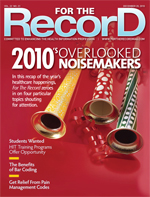 December 20, 2010
December 20, 2010
Coding for Autism
For The Record
Vol. 22 No. 23 P. 28
Autism is a developmental disorder that affects a person’s ability to communicate and interact with others. Commonly appearing in early childhood, the symptoms and the severity vary greatly, but early detection and treatment are helpful. Signs of autism often appear by the age of 18 months, but the condition is usually not diagnosed until the age of 2 or 3 when more obvious delays are present.
The cause of autism is unknown, although researchers believe genetics and environmental factors may play a role. It has long been discussed that there may be a link between vaccinations and autism. However, nothing has been proven that any particular vaccination has increased the risk of autism.
Autism is assigned to ICD-9-CM code 299.0. A fifth digit subclassification is required as follows: 299.00, Current or active state; or 299.01, Residual state. If the state is unspecified, it defaults to code 299.00.
Parents concerned with vaccinations causing autism may refuse to have their child vaccinated; this is assigned to code V64.05, Vaccination not carried out because of caregiver refusal. Code V15.83 is assigned for children who are underimmunized.
Autism is a part of the autism spectrum disorders, which includes Asperger syndrome (299.80 to 299.81) and pervasive developmental disorder, not otherwise specified (299.90 to 299.91). Patients with Asperger usually have milder symptoms than autism and do not have problems with language or intellectual disability. Those with pervasive developmental disorder, which may also be documented as atypical autism, have fewer and milder symptoms than autism. Symptoms are related to social and communication challenges.
Symptoms
Children with autism generally have problems in three areas of development: social interaction, language, and behavior. The following are the most common symptoms of autism in the three developmental areas:
• Social skills: fail to respond to name, poor eye contact, appear not to hear at times, resist cuddling and holding, appear unaware of others’ feelings, and seem to prefer playing alone.
• Language: start talking later than the age of 2, developmental delays present by the age of 30 months, lose previously learned words, don’t make eye contact when speaking, speak with an abnormal tone or rhythm, can’t start a conversation or keep one going, and may repeat words or phrases verbatim but don’t understand them.
• Behavior: perform repetitive movements, develop specific routines or rituals, become disturbed at the slightest change in routines or rituals, move constantly, may be fascinated by parts of an object, and may be unusually sensitive to light, sound, and touch and yet oblivious to pain.
Diagnosis
Diagnosing autism is difficult due to the wildly varying degrees of severity. There is not a specific diagnostic test that can be done to confirm the diagnosis. Instead, the diagnosis is based on observation of the child and discussion with the parents. The physician may perform developmental tests to evaluate speech, language, and psychological issues.
Treatment
Although there is no cure for autism, early detection and intervention is beneficial. Treatment options include behavior and communication therapies, educational therapies, and medications to control symptoms, such as antidepressants and antipsychotics.
Patients with autism may have other medical conditions that need to be treated, such as epilepsy and gastrointestinal problems.
Coding and sequencing for autism are dependent on the physician documentation in the medical record and application of the Official Coding Guidelines for inpatient care. Also, use specific AHA Coding Clinic for ICD-9-CM and American Medical Association CPT Assistant references to ensure complete and accurate coding.
— This information was prepared by Audrey Howard, RHIA, of 3M Consulting Services. 3M Consulting Services is a business of 3M Health Information Systems, a supplier of coding and classification systems to more than 5,000 healthcare providers. The company and its representatives do not assume any responsibility for reimbursement decisions or claims denials made by providers or payers as the result of the misuse of this coding information. More information about 3M Health Information Systems is available at www.3mhis.com or by calling 800-367-2447.



